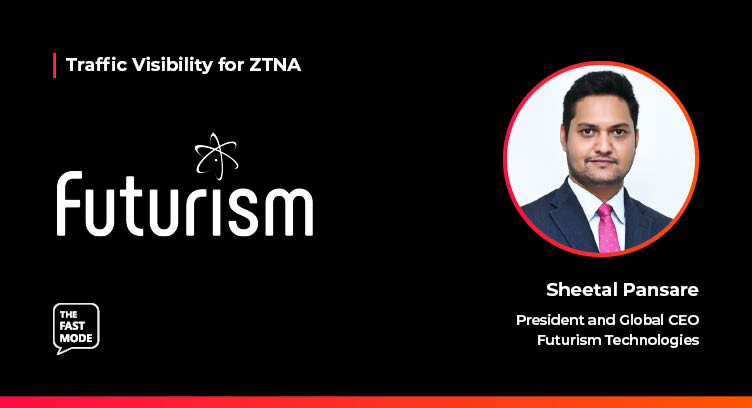The Fast Mode spoke to Sheetal Pansare, President and Global CEO of Futurism Technologies on the impact of traffic visibility on ZTNA networks. Sheetal joins us in a series of discussions with leading cybersecurity and networking vendors, assessing the evolution of ZTNA technologies, the roadmap for ZTNA deployments, the benefits of ZTNA for enterprise and telco networks, and the need for real-time traffic visibility technologies such as DPI for ZTNA.
Ariana: Why is ZTNA the future of enterprise security?
Sheetal: In the rapidly evolving cybersecurity landscape, Zero Trust Network Access (ZTNA) emerges as a beacon of innovation. This paradigm shift, from a traditional 'trust but verify' to a 'never trust, always verify' methodology, is not just a change in security protocols but a fundamental rethinking of enterprise security strategy.
At its core, ZTNA embodies the principle of zero trust - an essential pivot in an era where cyber threats are increasingly sophisticated and perimeter-based defenses are no longer sufficient. By treating each user, device, and application as separate entities requiring constant verification, ZTNA presents a dynamic, adaptive security posture. This approach is particularly resonant in today's work environment where remote access has become the norm, thereby expanding the threat landscape.
Integrating ZTNA within the broader Secure Access Service Edge (SASE) framework is a forward-thinking move, reflective of a deep understanding of the complexities of modern network environments. This integration provides a scalable, agile solution, crucial for organizations navigating the shift to cloud-based operations and remote workforces.
The decline of traditional VPNs in favor of ZTNA is a testament to its efficacy. By addressing scalability and security flaws inherent in VPNs, ZTNA offers a robust alternative, enhancing network integrity and resilience against cyber threats like ransomware – a rising concern for enterprises globally.
It's evident that ZTNA is not just a technology or a tool; it is a strategic imperative. It represents a proactive, informed response to the evolving digital threat landscape, ensuring that enterprises are not just defending against today's threats but are also prepared for the challenges of tomorrow. At Futurism Technologies, we position ZTNA as a cornerstone in the future of cybersecurity.
Ariana: How does ZTNA enhance telecom operator networks?
Sheetal: Telecom operators are increasingly facing a variety of cyber threats that challenge both their technical and business viability. Traditional network architectures, which are built on the premise of implicit trust, are becoming inadequate in this rapidly evolving digital landscape.
ZTNA addresses these challenges by shifting the focus from implicit trust to a model where trust is never assumed and must always be verified. This approach is particularly relevant for telecom operators, whose networks often include diverse and dispersed infrastructures like private, public, and multi-cloud deployments, remote workforces, and a wide range of interconnected IoT and OT devices.
- Enhanced Security Posture: ZTNA's core principle of "never trust, always verify" extends beyond user credentials to include a comprehensive evaluation of the assets that the users interact with and the level of access granted after authentication. This approach helps in mitigating risks associated with diverse user devices and unsecured networks.
- Segmentation and Isolation: Critical in preventing domain-wide breaches, ZTNA's ability to segment and isolate systems within a network enhances security by containing potential threats within manageable boundaries.
- Policy-Driven Access Control: ZTNA leverages a granular, policy-driven approach to access control, focusing on entitlement and the environment as much as on authentication. This adaptability allows telecom operators to dynamically adjust policies based on real-time security intelligence and user behavior.
- Adaptability to Complex Environments: ZTNA is well-suited to address the complexity inherent in modern IT infrastructures, including cloud environments and evolving attack surfaces, making it an intelligent and robust framework for securing complex network environments.
By implementing ZTNA solutions, telecom operators can transition from rigid and disjointed IT architectures to more converged security platforms, leading to significantly reduced costs, seamless network connectivity, zero downtime, and robust defenses against emerging threats.
Sheetal Pansare is the President & Global CEO at Futurism Technologies based in the USA. He is an ardent evangelist of digital transformation. Having been in the tech industry for over two decades, he believes that now is the right time to reimagine how we see, perceive and access digital technologies and solutions.
This interview is a part of The Fast Mode's Next-Gen DPI Traffic Visibility for ZTNA segment, featuring over 40 leading cybersecurity and networking solution providers and their views on the importance of traffic visibility for ZTNA. A research report on this topic will be published in January 2024 - for more information, visit here.


















